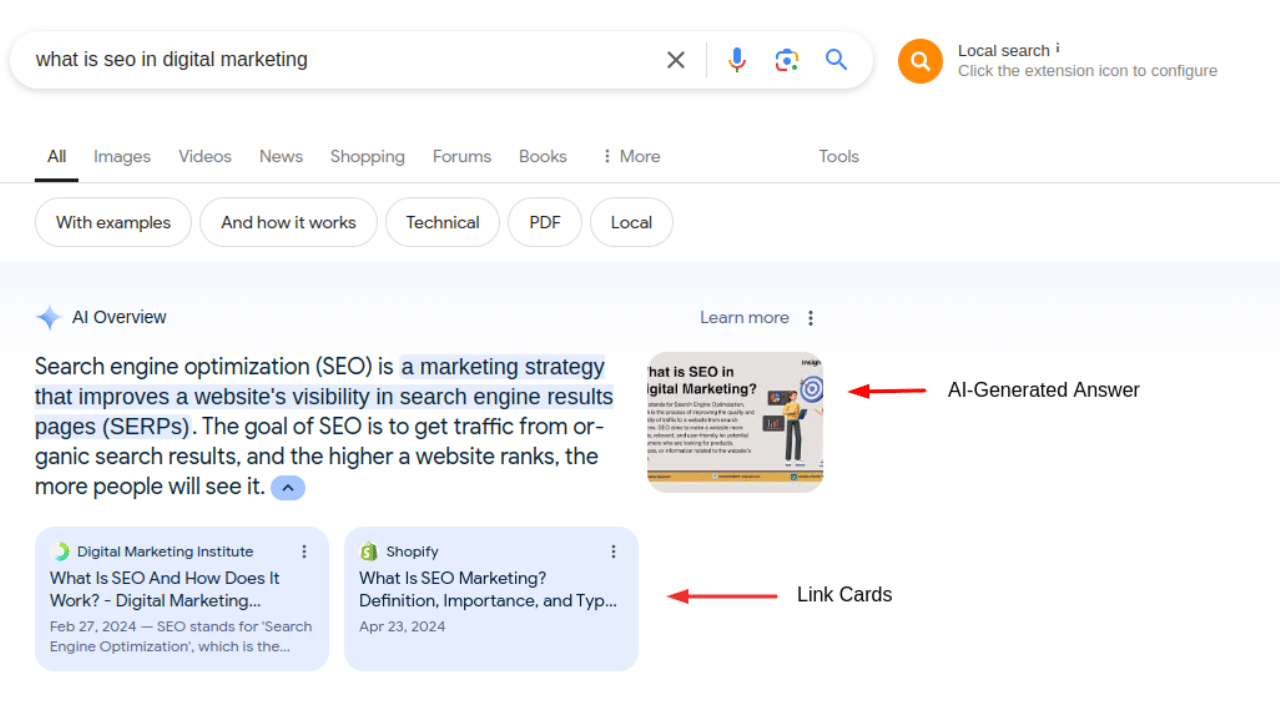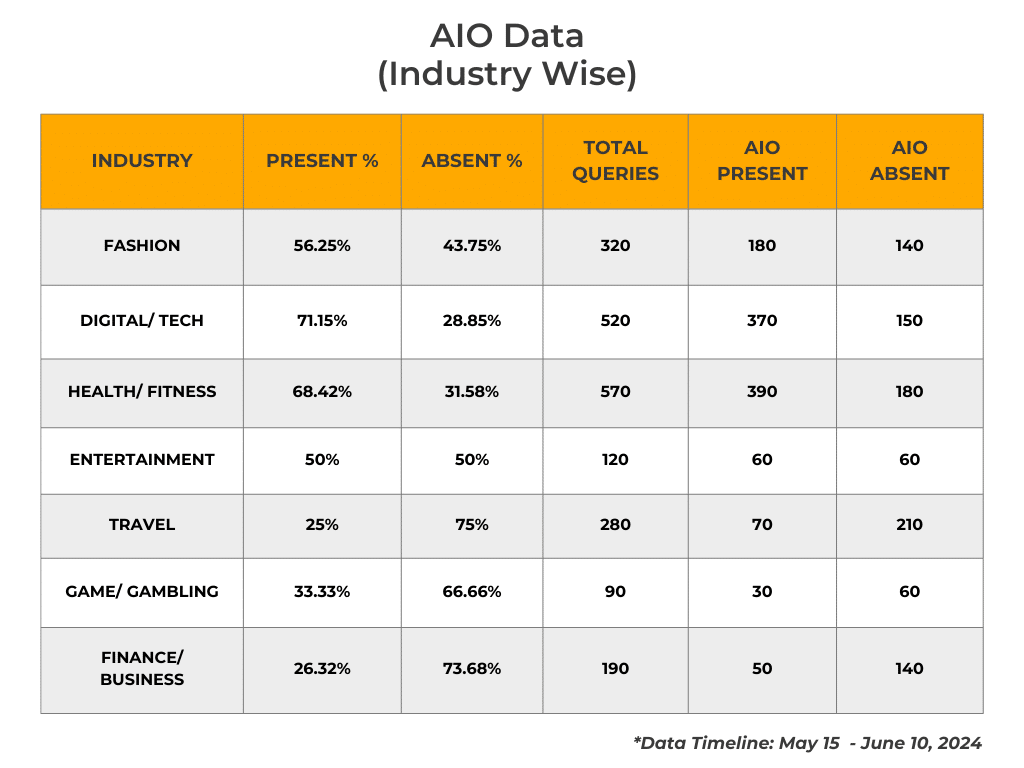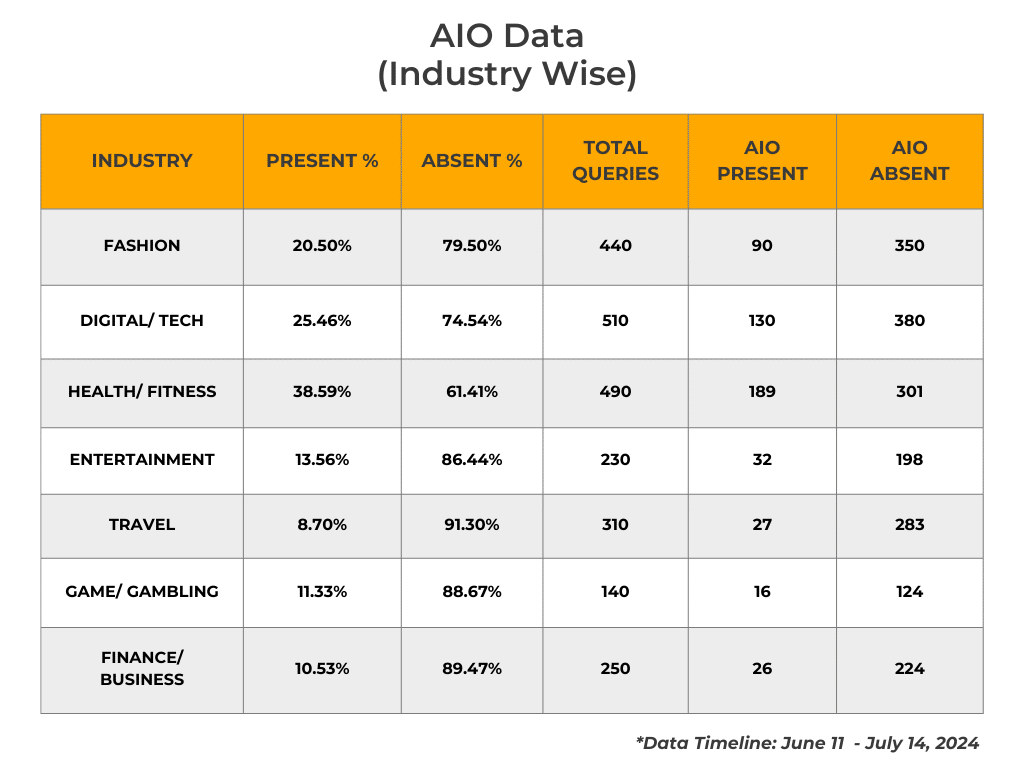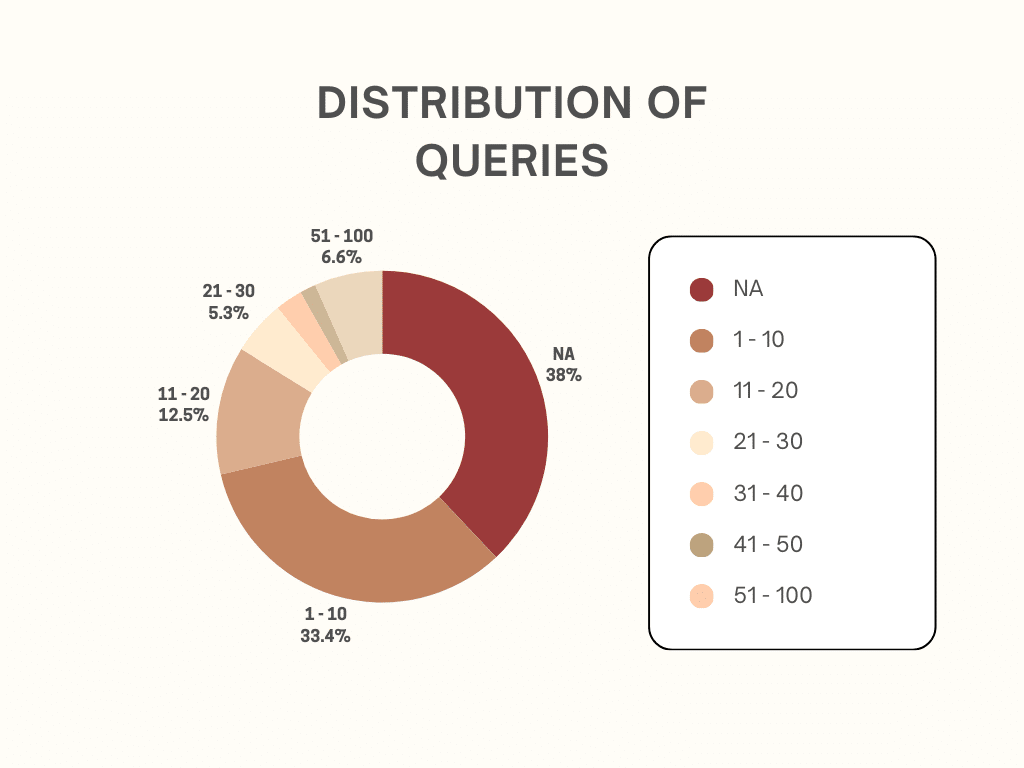It’s been almost two months since the official launch of AI Overviews, and since its release, all SEO experts and marketers have been thinking about how this new Google search feature will impact their organic search performance and ranking.
Since its launch, we’ve rigorously tested this new feature and have answers to all your burning questions. So, if you want to learn more about AIO’s impact on SEO, keep reading!
What are Google AI Overviews?
Google AI Overviews, which was initially called Search Generative Experience (SGE), is a search result feature powered by the recent version of Google’s large language model, Gemini.
AI Overviews appear at the top of the search result page. The main idea behind them is to provide you with an AI-generated summary of your query along with links to relevant sources for more information.
For instance, if you search “What is SEO in digital marketing,” Google will show an AI-generated answer at the top of the page like this.

This innovation aims to improve user experience and save time by providing users with quick answers to their queries so that they don’t have to visit multiple websites.
AI Overviews became available to everyone in the U.S. on May 14, 2024. By the end of 2024, it is said to be available to more than 1 billion people worldwide.
AI Overview’s Impact on SEO
Since the emergence of AIO in Google Search, concerns have been raised about a possible decline in organic traffic. As AI-generated summaries deliver quick and comprehensive answers directly on the search results page, users may have less motivation to visit individual websites.
This change could significantly reduce organic traffic, particularly for sites offering straightforward answers to informational queries, potentially cutting clickthrough rates by over 50%.
However, the effect on organic traffic may not be entirely negative. While some websites might experience a drop in visits, others could see gains in visibility and credibility from being featured in AI Overviews.
So, it’s important to recognize that since Google depends heavily on external content, it is unlikely to completely overshadow marketers and content creators.
Appearance of AI Overviews in Search Results
Since its release, we’ve rigorously tested AI Overviews to understand its impact on search results. In our previous blog, we shared our initial findings based on an analysis of 445 search queries. During the SGE stage, we observed AI Overviews appearing in approximately 66% of cases, a promising start that exceeded our expectations.
However, the landscape has shifted significantly since then. To gain a more comprehensive understanding, we’ve expanded our analysis to include over 2,000 additional search queries. Surprisingly, despite this substantial increase in data points, the prevalence of AI Overviews has not grown. On the contrary, it has declined.
Our latest data indicates that AI Overviews currently appear in only about 13% of queries, a stark contrast to the initial 66% and even lowerthan the 16% we reported in our earlier analysis.
| It’s important to note that the percentage of queries showing AI Overviews can be influenced by various factors, including the specific nature of the query. As we will explore later in this blog, certain types of queries are more likely to trigger AI Overviews than others. |
Industry-Wise Impact

Going into more detail, we’ve also been tracking AIO’s impact on various industries, checking how it’s affecting each area individually. As you can see in the table above, during our initial testing phase (May 15th – June 10th), AIOs were present for a majority of the questions asked across most industries.
Exceptions included travel, gaming/gambling, and finance/business, which saw comparatively fewer AIOs from the start. On average, AIOs were present for about 47% of search queries during this period.

However, a drastic change was observed during the following testing phase (June 11th – July 14th). The presence of AIOs wasn’t reduced in any specific niche; instead, there was a significant decline across every industry.
The average presence percentage dropped down to only 14%, which represents a remarkable 70% decrease from our initial findings.
Notably, the Travel and Entertainment industries experienced the most substantial declines, with Travel dropping from 25% to a mere 8.70% and Entertainment falling from 50% to 13.56%.
On the other hand, health related queries experienced the least decline i.e. from 68.42% to 38.59%. However, it is worth noting that healthcare queries are now more frequently displaying warning messages at the end, signaling the need for caution.

Not only that, but the physical space occupied by AI Overviews at the top of search results has also decreased by approximately 13%. This reduction indicates Google’s effort to strike a balance between the visibility of AI-generated content and traditional search results.
Reasons For Decline
The reduction in AI overviews may be linked to various factors. However, a significant contributing factor could be the widely reported instances of incorrect and even hazardous AI-generated responses.
Because, well, it’s no shock that people tend to lose trust when AI suggestions include advice as bizarre as consuming rocks or applying glue to pizza.
When Do AI Overviews Appear?
In our previous blog, we also mentioned that AI Overviews aims to answer your more complex queries that usually require you to do multiple searches. However, that is not all; we’ve observed that AIO also tends to appear more for informational queries. Another thing we’ve noticed is that Featured Snippets and question-based keywords are the most likely factors to trigger an AI Overview (AIO).
On the other hand, the presence of site links (usually seen with brand queries) and local packs are negatively correlated with AIO appearances. This matches Google’s description of the role of AIO: they are designed to help users when further exploration of a topic may be needed. Since brand queries and local packs are mainly navigational and transactional, they don’t often lead to AI Overviews.
For marketers, this is a crucial insight. By focusing on keywords that are questions and those that generate Featured Snippets, you can better optimize for AIOs. This information allows you to refine your strategy to target both traditional search results and those influenced by AIO triggers.
AIOs Contain More Citations Than Before
Following concerns over AI hallucination, Google has enhanced the accuracy of its AI Overviews by increasing the number of citations. In our recent analysis of 2,370 keywords, we observed that the average number of citations has risen from a mere 8-10 to around 15-20.
This addition of more outgoing links to webpages is a positive development for the open web, as it enhances the chances of users exploring the original content, ultimately benefiting both users and content creators.
This move by Google demonstrates a commitment to providing more accurate and trustworthy information while supporting the broader online ecosystem.
Do These Citations Need to be Ranked Organically?
Short answer – not really!
In our analysis, we found that for about 38% of queries, the links mentioned in AI overviews are not even ranked organically.
One reason could be that AIO aims to predict and answer the next question a user might have after their initial search query without requiring the user to pose that follow-up question. As a result, many of the citations used by AI overviews differ from those in traditional search results.
This means that now marketers have a unique opportunity to address various queries with multiple URLs within a single search result.

A Significant Drop Noticed in User-Generated Content
In our recent analysis, we also observed a significant decline in the presence of links from social platforms like Reddit and Quora, which were notably prevalent in the early stages.
Our data sample of 2,370 queries revealed a stark contrast, with only 3 links from Quora and 2 from Reddit. The decrease can likely be attributed to Google’s evolving algorithms, which may prioritize more reliable sources over those perceived as less credible.
How Can You Optimize for AI Overviews: Best Practices
“There is nothing special for creators to do to be considered other than to follow our regular guidance for appearing in search, as covered in Google Search Essentials.” according to Google.
So, while there are no fixed guidelines yet, there are certainly some best practices that one can follow to increase their chances of getting featured in the link cards.
Below, we’ll cover these practices in detail.
-
Create Quality Content
Like any other search algorithm, Google’s AI is designed to prioritize content that offers real value to users. Here’s how to ensure your content stands out:
- Understand Your Audience: Know who your audience is and what they care about. Use this understanding to create content that addresses their needs and interests.
- Provide Value: Offer solutions to problems, answer questions, and provide insights that are not easily found elsewhere.
- Use Clear and Concise Language: Avoid jargon and complex sentences. Aim for clarity and simplicity to make your content accessible to a broader audience.
- Incorporate Multimedia: Use images, videos, infographics, and charts to make your content more engaging and easier to understand.
-
Focus on Content Structure
A well-structured article is easier for both users and AI to understand and digest. To optimize your content structure, utilize:
- Headings and Subheadings: Use clear and descriptive headings (H1, H2, H3) to break up your content into manageable sections. For example, an article on home renovation could have sections like “Planning Your Renovation,” “Budgeting Tips,” and “DIY vs. Hiring Professionals.”
- Bullet Points and Lists: Use bullet points and numbered lists to highlight key points and steps. This makes your content scannable and easier to follow.
- Short Paragraphs: Keep paragraphs short (2-3 sentences) to maintain reader interest and ensure better readability.
-
Target Long-Tail Keywords
Long-tail keywords are specific phrases that users are likely to search for. They often have lower competition and higher conversion rates. Here’s how to effectively use long-tail keywords:
- Research: Use tools like Google Keyword Planner, Ahrefs or SEMrush to find long-tail keywords relevant to your industry. For instance, instead of targeting a broad term like “shoes,” target “best running shoes for flat feet.”
- Incorporate Naturally: Integrate long-tail keywords naturally into your content without keyword stuffing. For example, in a blog post about cooking, you might use “easy vegetarian recipes for beginners.”
-
Prioritize Backlinks
Backlinks are links from other websites to your content. They signal to search engines that your content is valuable and trustworthy. Here’s how to prioritize backlinks to improve your SEO:
- Create Link-Worthy Content: Produce content that others find valuable and want to link to. This could be comprehensive guides, original research, infographics, or high-quality videos.
- Guest Blogging: Write guest posts for reputable websites in your industry. This not only builds your authority but also provides opportunities to link back to your site.
- Outreach: Reach out to influencers and other website owners in your niche. Share your content with them and explain why it would be beneficial for their audience.
-
Utilize On-Page SEO Techniques
On-page SEO involves optimizing individual web pages to rank higher and earn more relevant traffic in search engines. Here are some on-page SEO techniques to consider:
- Title Tags and Meta Descriptions: Craft compelling and relevant title tags and meta descriptions for each page. These elements appear in search results and influence click-through rates. For example, a title tag like “10 Essential SEO Tips for Beginners” is clear and enticing.
- Header Tags: Use header tags (H1, H2, H3) to organize your content and highlight important sections. This helps search engines understand the structure and relevance of your content.
- Internal Linking: Link to other relevant pages on your website. This not only helps users navigate your site but also helps search engines understand the relationship between different pieces of content.
- Keyword Optimization: Include your target keywords in strategic places like the title, headers, and throughout the content. However, ensure it reads naturally and doesn’t feel forced.
-
Improve User Experience
A positive user experience is important for retaining visitors and reducing bounce rates. Google’s algorithms take user engagement metrics into account when ranking pages.
- Responsive Design: Ensure your website is mobile-friendly and responsive. With more users accessing the web via mobile devices, a responsive design is essential.
- Page Speed: Optimize your website’s loading speed. Slow-loading pages can frustrate users and lead to higher bounce rates.
- Navigation: Create an intuitive and easy-to-navigate website structure. Users should be able to find what they’re looking for quickly and easily. For example, use clear menus and breadcrumbs.
-
Ensure Your Web Pages are Indexable and Crawlable
Crawling is the process where search engine bots discover new and updated pages by following links, while indexing involves storing and organizing this content in a database so it can be retrieved during a search query.
- Robots.txt File: Ensure your robots.txt file is not blocking important pages from being crawled. This file guides search engine bots on which pages to access and which to ignore.
- XML Sitemap: Create and submit an XML sitemap to search engines. This acts as a roadmap, helping bots discover and index all your important pages efficiently.
- Fix Broken Links: Regularly check for and fix broken links to ensure a smooth user experience and maintain site integrity. Broken links can impede crawling and harm your site’s SEO.
- Use Canonical Tags: Prevent duplicate content issues by using canonical tags. These tags tell search engines which version of a page should be considered the primary one, consolidating link equity and avoiding content duplication penalties.
-
Leverage Schema Markup
Schema markup is a form of microdata that helps search engines better understand your content and provide more informative results. Here’s how to use schema markup:
- Rich Snippets: Implement schema markup to enhance your search listings with rich snippets. This can include additional information like ratings, reviews, and images. For example, a recipe website can use schema markup to display cooking times, ratings, and ingredients in search results.
- Local SEO: If you have a local business, use schema markup to provide search engines with information about your location, hours of operation, and contact details.
- Product Information: For e-commerce sites, use schema markup to provide detailed product information, including price, availability, and reviews.
Wrapping It Up
The emergence of AI Overviews (AIO) in search results has sparked a number of questions for SEO professionals. While initial concerns centered around a decline in organic traffic, recent data suggests a more nuanced picture.
AIOs appear less frequently than initially anticipated, and Google seems to be prioritizing accurate and trustworthy information.
The key takeaway for SEO remains creating high-quality, informative content that addresses user needs. By focusing on best practices like keyword research, content structure, and user experience, you can increase your chances of not only ranking well in traditional search results but also being featured in AIOs.
